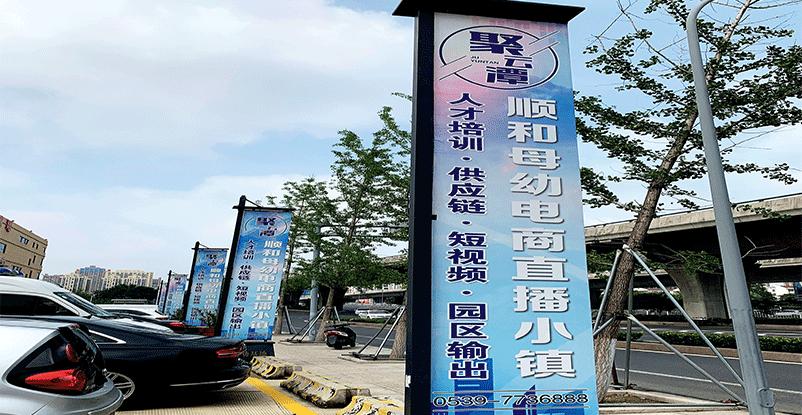Linyi’s livestreaming centers attracted attention as industries, especially offline ones, were heavily impacted by the Covid-19 pandemic. Many regions hoped that they could copy Linyi’s model and restore local commerce.
In April, Alibaba launched what it called the Chunlei 2020 (Spring Thunder 2020) program. Alibaba said it would establish 100 livestreaming centers in each province within three years. According to lanjinger.com, a financial news website, by mid-July, Kuaishou had built 20 livestreaming centers across the country. Earlier this year, the government of Guangzhou, South China’s Guangdong Province, said it would become a “capital of livestreaming commerce,” with plans to build a cluster of livestreaming centers. Following Guangzhou, other cities with rich e-commerce experience announced similar plans, including Hangzhou, where Alibaba is headquartered, and Yiwu, a global center for small commodity export trade, both in Zhejiang Province.
According to Nie and Guo, those who flock to visit them are mostly officials and property developers from smaller cities who want people from Linyi to help them build a livestreaming center. The city or businessperson will provide the space for a center, often an empty building which would need remodeling, free of charge. Even if the center is built from scratch, profits can still be made. An insider in the livestreaming sales industry who asked for anonymity told NewsChina that impacted by e-commerce, rents for office buildings are falling, but if a building is slated for livestreaming sales, the rent will rebound.
“Investors aren’t attracted by traditional commerce anymore, but they’ll definitely buy into livestreaming sales,” he said.
For local officials, it is more about the effects of the livestreaming centers. They care about how many livestreamers the center can train, how many jobs it can offer, and how much it can help boost the sales of local specialties.
Not everyone is sure the Linyi model can be successfully replicated. Jia and Chen believe it can, especially as they plan to build a center in 16 more cities in Shandong. Livestreaming centers in other provinces are already under construction.
Livestreamers in other regions can start by selling local specialties or other products provided by Linyi, they said. Once the livestreaming sellers grow their sales to a certain scale, the supply chain and logistics system will follow.
Nie is not as optimistic. He is cautious about cooperating with small cities and counties. “Not every city can financially support a livestreaming center like the ones in Linyi. I think it is not really achievable for a town or even a county, so we won’t consider cooperating with a county-level region,” he said.
Even for a city, Nie looks at a lot of indicators, such as the local user registration on video and livestreaming apps, the number of local daily live users and the local e-commerce potential. He refused to cooperate with two cities in Central China as they did not have enough registered users on Kuaishou and Douyin. According to Nie, the sellers in the two cities are more accustomed to offline sales and without a large base of online followers, they are not suitable for the cheap bulk-buying model of livestream sales.
“The hardest thing is for a seller to educate customers,” he said.
Nie’s team is only involved in four projects in other cities. Despite the growth of the livestreaming industry, Nie predicted that many of the livestreaming centers would close within a year, either because they are in a place that is not suited to e-commerce or because of lack of experience.
He Haoxun, content commercialization director of Kuaishou agrees. “Service is the key for livestreaming centers,” he said. “If you just provide land, you won’t be competitive.” He said that there were similar problems several years ago when many cities rushed to build e-commerce industrial zones.
According to a 2018 survey report by the Qianzhan Industry Institute, by 2018, China had more than 100 e-commerce industrial zones, but because of the absence of an established industrial chain, insufficient support facilities and not enough experienced operators, many of those zones only make money from rent, while others failed to promote the local area as governments had anticipated.
In 2015, Zhang Zhouping, a senior analyst at the China E-commerce Research Center was quoted by the China Business Herald as saying that at least half of the e-commerce industrial zones have experienced difficulties. According to Zhang, some of the zones are just a way to obtain land by dangling the prospect of an e-commerce zone.
If livestreaming centers are to be successful, they will have to move quickly to prevent the type of problems e-commerce industrial zones have encountered. Du Qingming, the industrial development director of the Market Administration Commission of Lanshan District in Linyi, told NewsChina that Linyi government is working on a regulation to standardize the management of livestreaming centers.
“Those not suitable for the livestreaming industry or who have no experience operating a livestreaming center will be swept away in a year,” Nie said. “Only the really good ones will survive.”

 Old Version
Old Version


